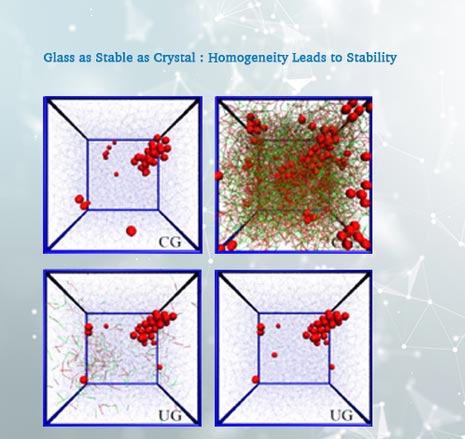Glass as stable as crystal

Researchers at The University of Tokyo use numerical simulations to model the process called devitrification during which glasses crystallize, which may help improve the long-term stability of glassy materials, like pharmaceuticals and smartphone screens.
Credit: Institute of Industrial Science, the University of Tokyo
… homogeneity leads to stability.
Scientists from The University of Tokyo Institute of Industrial Science used computer simulations to study the aging mechanism that can cause an amorphous glassy material to turn into a crystal. They find that removing tiny irregularities in local densities help prevent the atomic “avalanches” that trigger ordered structure formation. This work may lead to more stable glassy materials, including for pharmaceutical applications.
Glasses are highly unusual solids in that they lack an organized crystal structure. In fact, they are more like “frozen liquids,” because the atoms can get stuck in non-equilibrium positions. Over time, some glasses experience an aging process or devitrification, in the latter of which the amorphous configuration settles into a more regular structure. In most cases, devitrification is undesirable, as it can turn previously transparent materials opaque. In addition to aesthetic considerations, the lack of stability can cause damage to glass panes, as well as pharmaceuticals or optical media. However, the physical mechanism that triggers aging or devitrification remains poorly understood.
The team of researchers, led by The University of Tokyo Institute of Industrial Science, used computer simulations to study the process of devitrification. Instead of thermal annealing, the team took a novel approach by starting with a “conventional glass” and progressively removing inhomogeneities in density until a “uniform glass” was formed. This new state showed unprecedented stability against devitrification. Lead author Dr. Taiki Yanagishima says, “This uniform glass state shows there is a clear connection between the stability of a glass state and its mechanical homogeneity.”
As with other forms of crystal growth, devitrification starts when a tiny “seed” crystal, called a nucleus, recruits neighboring atoms to arrange themselves in the same pattern. But unlike in liquids, the “seeds” in glasses only grow when they are given a shake by large intermittent coordinated movements of atoms called “avalanches.” In previous work, the researchers showed that these sudden events corresponded to destabilizations of the load-bearing network that spans the entire sample, and hypothesized that they were the only mechanism by which atoms may rearrange themselves. Making the glass more uniform prevents this relaxation and devitrification, even when nuclei are present. “When avalanches are prevented, nuclei that normally would grow into crystals are instead frozen in their glassy state,” senior author Professor Tanaka says. This leads to the possibility that by making the number of load-bearing atomic neighbors more uniform across the sample, ultra-stable glasses may be formed. This “mechanical homogenization” may open the way for stronger and more stable glasses.
The work is published in Physical Review Letters as “Towards glasses with permanent stability” (DOI:10.1103/PhysRevLett.127.215501).
About Institute of Industrial Science (IIS), the University of Tokyo
Institute of Industrial Science (IIS), the University of Tokyo is one of the largest university-attached research institutes in Japan.
More than 120 research laboratories, each headed by a faculty member, comprise IIS, with more than 1,200 members including approximately 400 staff and 800 students actively engaged in education and research. Our activities cover almost all the areas of engineering disciplines. Since its foundation in 1949, IIS has worked to bridge the huge gaps that exist between academic disciplines and realworld applications.
Journal: Physical Review Letters
DOI: 10.1103/PhysRevLett.127.215501
Article Title: Towards glasses with permanent stability
Article Publication Date: 16-Nov-2021
Media Contact
Hajime Tanaka
Institute of Industrial Science, The University of Tokyo
tanaka@iis.u-tokyo.ac.jp
Office: 81-3-5452-6125
Original Source
All latest news from the category: Physics and Astronomy
This area deals with the fundamental laws and building blocks of nature and how they interact, the properties and the behavior of matter, and research into space and time and their structures.
innovations-report provides in-depth reports and articles on subjects such as astrophysics, laser technologies, nuclear, quantum, particle and solid-state physics, nanotechnologies, planetary research and findings (Mars, Venus) and developments related to the Hubble Telescope.
Newest articles

Properties of new materials for microchips
… can now be measured well. Reseachers of Delft University of Technology demonstrated measuring performance properties of ultrathin silicon membranes. Making ever smaller and more powerful chips requires new ultrathin…

Floating solar’s potential
… to support sustainable development by addressing climate, water, and energy goals holistically. A new study published this week in Nature Energy raises the potential for floating solar photovoltaics (FPV)…

Skyrmions move at record speeds
… a step towards the computing of the future. An international research team led by scientists from the CNRS1 has discovered that the magnetic nanobubbles2 known as skyrmions can be…





















